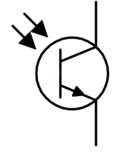Top Qs
Timeline
Chat
Perspective
Electronic symbol
Pictogram used to represent various electrical and electronic devices or functions From Wikipedia, the free encyclopedia
Remove ads
An electronic symbol is a pictogram used to represent various electrical and electronic devices or functions, such as wires, batteries, resistors, and transistors, in a schematic diagram of an electrical or electronic circuit. These symbols are largely standardized internationally today, but may vary from country to country, or engineering discipline, based on traditional conventions.

Remove ads
Standards for symbols
Summarize
Perspective
The graphic symbols used for electrical components in circuit diagrams are covered by national and international standards, in particular:
- IEC 60617:2025 (also known as BS 3939) - current international standard for electronic symbols.
- IEEE 315-1975[1] (also known as ANSI Y32.2-1975 or CSA Z99-1975) - reaffirmed in 1993, inactivated without replacement as of November 7, 2019.
- IEEE 91/91a - graphic symbols for logic functions (used in digital electronics). It is referenced in IEEE 315 / ANSI Y32.2.
- Australian Standard AS 1102 (based on a slightly modified version of IEC 60617) - withdrawn without replacement with a recommendation to use IEC 60617.
- DIN 40700 and 40900 (Germany) - inactivated.
- JIC JIC (Joint Industrial Council) symbols as approved and adopted by the NMTBA (National Machine Tool Builders Association). They have been extracted from the Appendix of the NMTBA Specification EGPl-1967.
- IEC 61131-3:2025 for ladder-logic symbols.
The standards do not all agree, and use of unusual (even if standardized) symbols can lead to confusion and errors.[2] Symbols usage is sometimes idiosyncratic to engineering disciplines, and national or local variations to international standards exist. For example, lighting and power symbols used as part of architectural drawings may be different from symbols for devices used in electronics.
Remove ads
Common electronic symbols
Summarize
Perspective
Symbols shown are typical examples, not a complete list.[3][4]
Traces

Grounds
The shorthand for ground is GND. Optionally, the triangle in the middle symbol may be filled in.
- Signal/low-noise ground (the asterisk is not part of the symbol)
- Chassis/Earth ground (IEC‑style)
Sources
Voltage text should be placed next to each battery symbol too, such as "3V".
- Battery, single-cell
- Battery, multi-cell
- DC voltage source
- Controlled DC voltage source
- Current source
- Controlled current source
- AC voltage source
Resistors
It is very common for potentiometer and rheostat symbols to be used for many types of variable resistors and trimmers.
- Photoresistor (ANSI)
- Thermistor (ANSI).[5]
- Use -t for NTC symbol.
- Use +t for PTC symbol.
- Varistor (ANSI)
Capacitors
Diodes
Optionally, the triangle in these symbols may be filled in, or a line may be drawn through the triangle (less desirable). The words anode and cathode aren't part of the diode symbols. For instructional purposes, sometimes one or two letters (A/C or A/K) are placed next to diode symbols similar to how the letters C/B/E or D/G/S are placed next to transistor symbols. "K" is often used instead of "C", because the origin of the word cathode is kathodos, and to avoid confusion with "C" for capacitors in silkscreen of printed circuit boards. Voltage text should be placed next to each zener and TVS diode symbol too, such as "5.1V".
- Diode (rectifier)
- TVS (Transient Voltage Suppression) diode. Top is unidirectional, bottom is bidirectional.
- LED (Light Emitting Diode)
- Diac (may be a varistor in older schematics)
Bridge rectifiers
There are many ways to draw a single-phase bridge rectifier symbol. Some simplified symbols don't show the internal diodes.
- Bridge rectifier
- Bridge rectifier
- Bridge rectifier
- Bridge rectifier
- Three-phase bridge rectifier
Inductors
An inductor can be drawn either as a series of loops, or series of half-circles.
- Inductor symbol (series of loops)
- Magnetic-core inductor (IEEE‑style)
- Tapped inductor (IEC‑style)
- Ferrite bead (IEEE‑style)
- Variable inductor
- Trimmer variable inductor
Transformers
Voltage text should be placed on both sides of power transformers, such as 120V (input side) and 6.3V (output side).
- Transformer with center tap on secondary winding (right side)
- Transformer with two secondary windings (right side)
- Zero-sequence current transformer (ZSCT) (also known as a window-type current transformer)
- Bushing-type current transformer
- Voltage transformer
Transistors
Optionally, transistor symbols may include a circle.[6] Note: The pin letters B/C/E and G/D/S aren't part of the transistor symbols.
Bipolar
- NPN Phototransistor
Unipolar
Vacuum tubes
Switches
For multiple pole switches, a dotted or dashed line can be included to indicate two or more switch at the same time (see DPST and DPDT examples below).
- Pushbutton, normally open, push-to-make (horizontal line on top)
- Pushbutton, normally open, push-to-make (IEEE-style)
- Pushbutton, normally closed, push-to-break (IEEE-style)
- Pushbutton, normally closed, two circuits (IEEE-style)
- Switch, 1P1T, SPST (single-pole single-throw)
- Switch, 2P1T, DPST (double-pole single-throw)
- Switch, 1P2T, SPDT (single-pole double-throw)
- Switch, 2P2T, DPDT (double-pole double-throw)
- Slide switch, 1P3T,
break-before-make, nonshorting style - Slide switch, 1P4T,
break-before-make, nonshorting style - Slide switch, 1P4T,
make-before-break, shorting style
- Rotary switch, 1P3T,
break-before-make, nonshorting style - Rotary switch, 1P4T,
break-before-make, nonshorting style - Rotary switch, 1P4T,
make-before-break, shorting style
- Reed switch, normally open
Relays
Relays symbols are a combination of an inductor symbol and switch symbol.
Note: The pin letters in these symbols aren't part of the standard relay symbol.
- SPST, SPDT, DPST, DPDT relays (American‑style)
- SPDT relay (IEC‑style)
Lamps
LED is located in the diode section.
- Indicating lamp (IEEE‑style)
- Indicatory incandescent light bulb
- Light bulb
Current limiters
- Molded-case circuit breaker (MCCB)
Voltage limiters
TVS and Zener diodes are located in the diode section.
- Gas-discharge tubes (GDT) for ESD discharge
Electro-acoustic devices
Speaker symbols sometimes include an internal inductor symbol. Impedance text should be placed next to each speaker symbol, such as "8 ohms".
- Loudspeaker
(IEEE-style) - Buzzer
(IEC-style) - Microphone
(IEEE-style) - Microphone
(IEC-style)
Antennas
- General antenna
(IEC-style) - Dipole antenna
(IEC-style) - Loop antenna
(IEC-style) - Loop antenna
(IEEE-style)
Cables
- Cable, Shielded 1 conductor
- Cable, 2 conductor
- Cable, Shielded 2 conductor with shield connected to ground
- Cable, 5 conductor
- Cable, Shielded 5 conductor
Connectors
There are numerous connector symbol variations.
- Phone connectors. "A" is TS, "B" is TRS, "D" is TRS with two switches.
- 5x2 shrouded header with notch key and pin names for Olimex UEXT.
ICs
Logic gates
For the symbols below: A and B are inputs, Q is output. Note: These letters are not part of the symbols.
There are variations of these logic gate symbols. Depending on the IC, the two-input gates below may have: 1) two or more inputs; 2) infrequently some have a second inverted Q output too.
- Inverter (NOT)
The above logic symbols may have additional I/O variations too: 1) schmitt trigger inputs, 2) tri-state outputs, 3) open-collector or open-drain outputs (not shown).
- Buffer gate with schmitt trigger input
- Buffer gate with tri-state output control.
(B is the tri-state control)
Flip-flops
For the symbols below: Q is output, Q is inverted output, E is enable input, internal triangle shape is clock input, S is Set, R is Reset (some datasheets use clear (CLR) instead of reset along the bottom).
There are variations of these flip-flop symbols. Depending on the IC, a flip-flop may have: 1) one or both outputs (Q only, Q only, both Q & Q); 2) one or both forced inputs along top & bottom (R only, S only, both R & S); 3) some inputs may be inverted.
- Simple SR flip-flop (inverted S & R inputs)
- Gated SR flip-flop
- Gated D flip-flop (Transparent Latch)
- Clocked D flip-flop
(Set & Reset inputs) - Clocked JK flip-flop
- Clocked T flip-flop
OpAmps
Note: The outside text isn't part of these symbols.
- Operational amplifier (opamp)
Voltage Regulator
Note: 3pin linear or LDO voltage regulator symbols typically have three words inside their symbols, such as "In" on left side, "Out" on right side", "Gnd" on bottom (for fixed output parts, such as LM7805) or "Adj" on bottom (for adjustable output parts, such as LM317).
- 3-pin Linear or LDO voltage regulator
- Example schematic of
3-pin voltage regulator
Oscillators
Frequency text should be placed next to each oscillator symbol, such as "16MHz".
- Crystal oscillator (IEEE‑style)
- Ceramic resonator (3 pins)
Miscellaneous devices
Remove ads
Historical electronic symbols
The shape of some electronic symbols have changed over time. The following historical electronic symbols can be found in old electronic books / magazines / schematics, and now considered obsolete.
Capacitors (historical)
All of the following are obsolete capacitor symbols.
- Obsolete capacitor (very old style)
- Obsolete capacitor
- Obsolete capacitor
- Obsolete capacitor
- Obsolete capacitor
See also
References
Further reading
External links
Wikiwand - on
Seamless Wikipedia browsing. On steroids.
Remove ads



























































































































